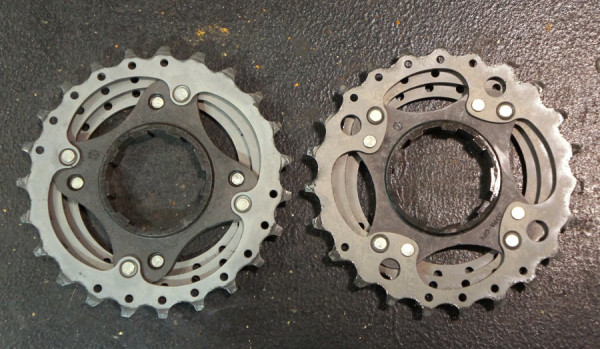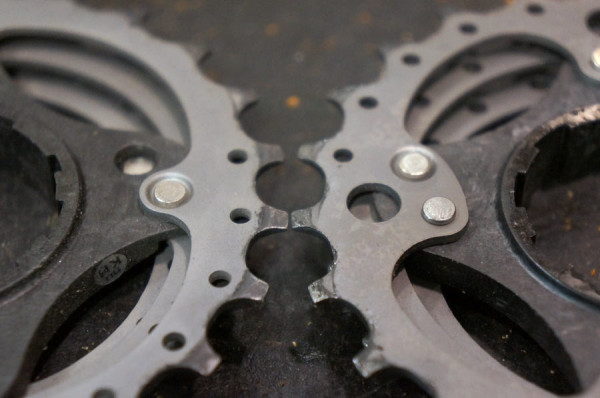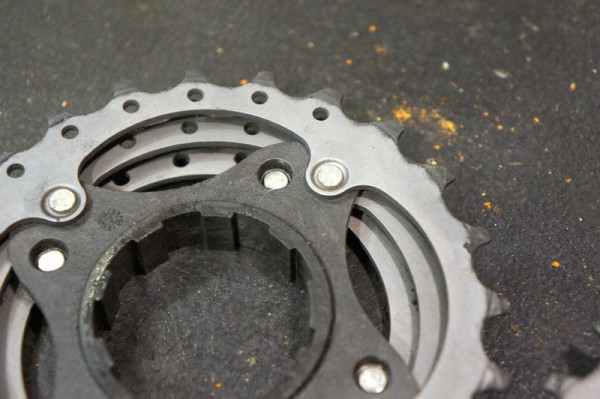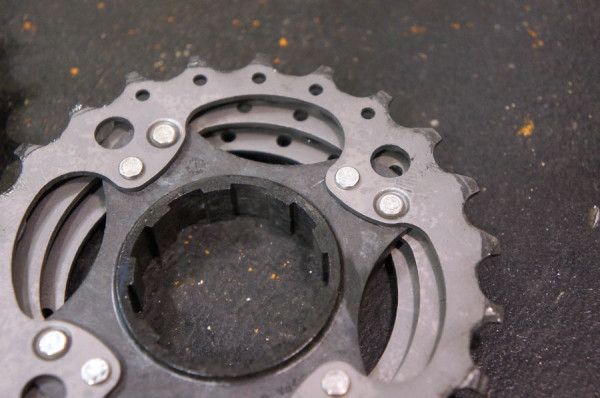
Rear derailleurs aren’t the only shadowy things around Shimano. Sometimes, mid-year updates are kept in the dark, too.
Thanks to an eagle eyed reader who wished to remain anonymous, we’ve learned that the 9000-series Dura-Ace cassette received a running change that added a rivet point to the largest cogs on the carbon fiber carrier’d center cluster. The change went unannounced and mostly unknown among the ranks – even some of their outside sales reps were unaware. We called their customer/tech support line and did get confirmation (beyond the obvious visual above) and an explanation. Apparently, the single rivet design can work slightly loose, causing creaking noises during use. The additional rivet strengthens the larger cogs connection to the carrier and prevents it from getting loose ‘n’ loud.
Is it a warranty-able issue? “If it’s creaking, yes,” said the customer service rep we spoke with. “We weren’t really seeing it on every cassette, but if it happens, you can send it in for replacement.”
UPDATE: Shimano clarifies creaking noise concern and explains changes. Full response pasted at bottom of post.
Mine is from the early stock (weights here) and hasn’t had any problems yet, but comforting to know (now that we do know) they’ll take care of it should something go wrong. And if you’ve been wondering where any random noise is coming from, check your cassette. More pics below…
RESPONSE FROM SHIMANO
Hi Bikerumor,
We make running changes to our products all the time. Any time we find a way to improve a product we’ll implement it into the next production cycle. The changes are usually tiny and they are often done without a single complaint about the existing product. They are usually very simple changes that are almost never noticed like changing the thread retaining compound on a fastener, refining an anodization process, or making an adjustment to the mixture of materials that make up our brake pad compounds. It might also be a change to a process. For example, we recently switched from using traditional spoke tension meters in our Dura Ace wheel building room to using acoustic ones that measure the frequency of the noise when a spoke is plucked. We didn’t do it because it’s more accurate but because there are no moving parts that wear and require recalibration so the information is now more consistent from day to day.
In my time at Shimano I’ve seen a couple of instances where people notice a change and make incorrect assumptions about what it was for; this looks to be one of those cases. We simply found a way to improve the strength of the joint between the carbon carrier and the cog. The riveting is the most obvious sign of the improvement but it wasn’t the only thing that was changed. This new construction was implemented in December of 2013. We have not been seeing creaks that were caused by that single rivet design coming loose and I don’t know where the customer service rep got that information. I think maybe he made the obvious assumption as well. Of course, if the joint between the carrier and the cog starts to fail it will make noise but that’s different from a creak.
Creaks are notoriously hard to chase away sometimes and I’m worried that someone might assume that this running change will get rid of a creak when it probably won’t. I really think that the best advice for someone with creaking issues is to work with the guys at the local bike shop. Chasing away creaks takes experience and often a couple of spare parts to sub onto a bike to confirm the exact culprit. No one is better at that sort of thing than the pro mechanics at the local shop.
I’d still like to share a little more information about Dura Ace chains and cassettes and potential creaking issues because we have studied the phenomenon and we do know where it’s coming from. It’s from the interface between the chain and the cog. There is a part of the inner chain plate that rubs on a part of the teeth on the cogs as the chain rolls on and off the cassette that can make a little noise. It tends to only occur when the chain is at an angle like when it’s in the largest cogs. It also makes more noise on titanium teeth than steel ones which is why Ultegra cassettes may be quieter on some bikes. The noise is very much affected by lubrication and chains that use dry lube do tend to be much louder. We recommend leaving the factory grease on the chains and even adding a little wet lube if there’s noise until it goes away. Chains with a few hundred miles on them tend to be quieter because after a little bit of use the interference point wears away. Much of this information is already common knowledge at the local bike shop which is another reason why letting them help solve any creaking issue is always a good idea.
I hope that helps to shed some light on things.
Thanks,
Nick Murdick
Shimano Lead Technical Instructor



